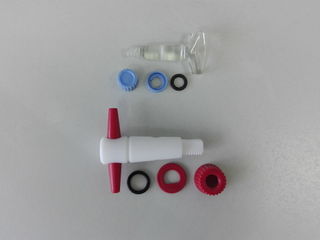Difference between revisions of "Stopcock"
(→Relevant Sciencemadness threads) |
|||
| (5 intermediate revisions by the same user not shown) | |||
| Line 1: | Line 1: | ||
{{Stub}} | {{Stub}} | ||
| − | A '''stopcock''' is a form of valve used to control the flow of a liquid or gas. | + | [[File:Stopcock PTFE and glass with seal screw.jpg|thumb|320px|Glass (above) and PTFE (below) stopcocks with rubber and plastic seal and their respective screw caps.]] |
| + | A '''stopcock''' is a form of valve used to control the flow of a liquid or gas in a lab item. | ||
==General== | ==General== | ||
| − | A stopcock consists of an elongated conical item with a handle and a ground glass joint, always male. Most models are full glass and have a two or three way bored holes and are full glass. Other models, are hollow and have two bored holes. Stopcocks are made of borosilicate glass or [[Polytetrafluoroethylene|PTFE]]. | + | A stopcock consists of an elongated conical item with a handle and a ground glass joint, always male. Most models are full glass and have a two or three way bored holes and are full glass. Other models, are hollow and have two bored holes. Stopcocks are always made of borosilicate glass or [[Polytetrafluoroethylene|PTFE]]. |
Stopcocks are often parts of laboratory glassware such as ([[automatic burette|automatic]]) [[burette]]s, [[chromatography column]], [[Dean-Stark apparatus]], [[dropping funnel]]s, [[gas collecting tube]], [[gas syringe]], [[Imhoff cone]], [[Schlenk flask]]s/[[Schlenk line|lines]], [[separatory funnel]]s, various [[adapter]]s. | Stopcocks are often parts of laboratory glassware such as ([[automatic burette|automatic]]) [[burette]]s, [[chromatography column]], [[Dean-Stark apparatus]], [[dropping funnel]]s, [[gas collecting tube]], [[gas syringe]], [[Imhoff cone]], [[Schlenk flask]]s/[[Schlenk line|lines]], [[separatory funnel]]s, various [[adapter]]s. | ||
| Line 10: | Line 11: | ||
Stopcocks can be bought from lab suppliers or online. | Stopcocks can be bought from lab suppliers or online. | ||
| − | You can also scavenge them from broken glassware, like [[separatory funnel]]s. | + | You can also scavenge them from broken glassware, like burettes, [[dropping funnel|dropping]] and [[separatory funnel]]s. |
==Maintenance== | ==Maintenance== | ||
| − | Make sure stopcocks are always well greased. Teflon stopcocks do not normally require greasing. | + | Make sure stopcocks are always well greased, to prevent them from freezing. Teflon stopcocks do not normally require greasing, but it's still a good idea to grease them, especially if you're handling burettes, where precision is crucial when titrating exact volumes. |
==References== | ==References== | ||
Latest revision as of 21:34, 7 April 2019
 |
This article is a stub. Please help Sciencemadness Wiki by expanding it, adding pictures, and improving existing text.
|
A stopcock is a form of valve used to control the flow of a liquid or gas in a lab item.
General
A stopcock consists of an elongated conical item with a handle and a ground glass joint, always male. Most models are full glass and have a two or three way bored holes and are full glass. Other models, are hollow and have two bored holes. Stopcocks are always made of borosilicate glass or PTFE.
Stopcocks are often parts of laboratory glassware such as (automatic) burettes, chromatography column, Dean-Stark apparatus, dropping funnels, gas collecting tube, gas syringe, Imhoff cone, Schlenk flasks/lines, separatory funnels, various adapters.
Availability
Stopcocks can be bought from lab suppliers or online.
You can also scavenge them from broken glassware, like burettes, dropping and separatory funnels.
Maintenance
Make sure stopcocks are always well greased, to prevent them from freezing. Teflon stopcocks do not normally require greasing, but it's still a good idea to grease them, especially if you're handling burettes, where precision is crucial when titrating exact volumes.
